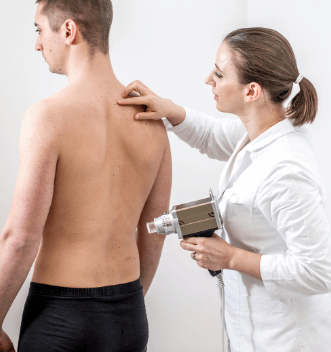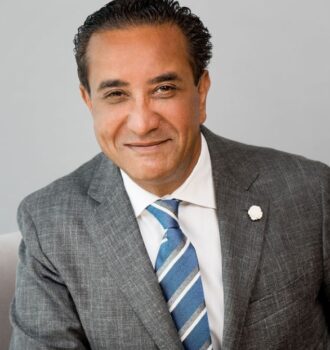Mole Mapping for Early Skin-Cancer Detection
 Non-Surgical Treatment
Non-Surgical Treatment Most moles are non–cancerous or benign, but can sometimes evolve into skin cancer. Skin cancer is not only highly curable, but is also the most preventable form of cancer when detected early. Mole mapping with the Fotofinder dermoscope is a technology we offer at ICLS that increases early detection of skin cancers.
At ICLS Dermatology, we understand the importance of monitoring and managing skin health, which is why we offer Mole Mapping using the advanced Fotofinder system. This non-invasive procedure is essential for early detection of skin cancer, providing peace of mind and proactive care for our patients.
ICLS Dermatology is a leader in comprehensive skin health services, servicing the Greater Toronto Area from our Oakville location. Our mole mapping services, led by Dr. Sheetal Sapra, ensure that you receive thorough and precise skin examinations. We encourage you to learn more about mole mapping in Toronto for skin cancer screening and peace of mind.

What is Mole Mapping?
Mole mapping is an advanced dermatological technique used to document and monitor the appearance of moles and other skin lesions over time. This full-body digital imaging system creates a visual record of your skin’s surface, allowing dermatologists to identify and track even the most subtle changes.
We utilize FotoFinder, a computerized system on a specialized platform that facilitates easier photo comparison. Patients with suspicious lesions or a strong family history of melanoma/skin cancer can be closely monitored using a standardized photo process that involves magnified photo images. Even minimal changes will be quickly identified and monitored appropriately.
People with dysplastic nevi and a family or personal history of melanoma are all candidates to have FotoFinder. Total body photography is the best way to track potential changes in moles and lesions for early detection of possible skin cancer.
Our mole mapping Ontario team will explain the entire process to you and identify any concerns you have prior to the appointment and process. As a skin cancer screening clinic, we can assure you that this process is direct, effective, and offers clear insight into your risks. We encourage you to seek out a mole check in Toronto, even if you are not sure you need a skin cancer screening check.
How Mole Mapping Differs from a Standard Skin Check
Unlike a basic visual exam, mole mapping captures high-resolution, magnified photographs of your skin, stored and compared over time. It’s ideal for detecting:
- New moles or lesions.
- Subtle changes in shape, colour, or border.
- Atypical features not easily caught in routine skin checks.
Why Mole Mapping is Important
Concerns of Skin Cancer
Skin cancer is Canada’s most common form of cancer. Melanoma, its most dangerous type, is highly curable when caught early. Mole mapping allows dermatologists to spot warning signs well before they become visible to the naked eye.
Early Detection
The key to better outcomes is early detection. Mole mapping helps flag potential melanoma or other skin cancers before they evolve into more serious health risks.
Tracking Subtle Changes
FotoFinder mole mapping is only effective when we can see the progression and changes over time. As a skin cancer screening clinic, we encourage you to visit us for ongoing support.
Approximately 6-12 months after your initial appointment, the nurse will take comparative photos that are matched against the initial baseline photos. The system automatically compares baseline and follow-up images, attempting to identify new lesions or changes to existing ones. Suspicious lesions can be quickly marked so that Dr. Sapra can determine the best course of action.
If there is a concern about a lesion, a biopsy may be necessary to confirm the diagnosis. To track and monitor changes in lesions, FotoFinder should be done every 6-12 months. Our skin cancer screening service in Toronto ensures that you learn about potential risks quickly, identifying those threats as soon as possible.
Advantages of Mole Mapping
Identifying Your Risk Factors
Mole mapping is especially valuable for patients who are at increased risk of skin cancer. If you answer “yes” to any of the following, you may benefit from mole mapping:
High-Risk Individuals
- Fair skin that burns easily.
- Personal or family history of melanoma.
- History of indoor tanning or severe sunburns.
- Numerous or atypical (dysplastic) moles.
- Immunocompromised (due to chemotherapy, HIV, transplant, etc.).
Peace-of-Mind Seekers
- You have a mole in a hard-to-see area (like your back).
- You’ve noticed changes in size, colour, or shape.
- You want an annual photographic baseline to track changes over time.
- You’re committed to proactive health monitoring.
The Mole Mapping Process at ICLS
Step-by-Step: What to Expect During Your Appointment
- Initial Consultation: Our team discusses your medical history and concerns.
- Baseline Imaging: Using the FotoFinder system, we take a series of full-body and close-up photos.
- Image Analysis: The software compares your moles against clinical patterns, flagging suspicious changes.
- Dermatologist Review: Dr. Sapra’s team reviews results and discusses any findings or next steps.
Advanced Technology for Precision and Accuracy
FotoFinder is one of the most advanced mole mapping systems available, using AI-assisted dermoscopy and automated comparison tools to detect evolving lesions.
Follow-Up and Ongoing Surveillance
To track changes over time, follow-up sessions are typically recommended every 6 to 12 months. Each visit overlays new images onto your original baseline, enabling precise detection of new or changing moles.
Benefits of Mole Mapping
- Early cancer detection.
- Non-invasive, pain-free monitoring.
- Detailed visual records over time.
- Peace of mind for those at risk or with a history of skin concerns.
- Accurate tracking of suspicious or evolving moles.
- Reduced need for unnecessary biopsies.
Safety and Comfort
Non-Invasive and Painless Procedure
No needles, no incisions, no recovery time. Mole mapping is completely non-invasive and suitable for all ages and skin types.
Privacy and Discretion
Photography is conducted respectfully and professionally. Patients may choose to wear modest garments or cover specific areas as needed.
Expert Medical Supervision
Each mapping session is reviewed by Dr. Sheetal Sapra, a board-certified dermatologist with over 35 years of experience and a national reputation in skin cancer prevention and detection.
Final Thoughts on Mole Mapping
Mole mapping is one of the smartest ways to take control of your skin health. It combines technology, medical oversight, and proactive planning to help detect melanoma and other skin cancers before they become serious.
Book your mole mapping consultation today at ICLS in Oakville, serving patients throughout the Greater Toronto Area.
Featured Video
Frequently Asked Questions
-
Is mole mapping covered by OHIP or private insurance?
No, mole mapping is not currently covered by OHIP. However, some private insurance plans may reimburse it if deemed medically necessary. Please check with your provider. The cost at ICLS is $599 per session.
-
How often should I get mole mapping done?
We recommend every 6 to 12 months, especially for high-risk individuals or those with numerous or atypical moles.
-
What should I do to prepare for my mole mapping appointment?
- Wear loose, comfortable clothing.
- Remove makeup or self-tanner.
- Avoid recent sunburn or tanning.
- Let us know about any new or changing moles.
-
Does mole mapping use radiation?
No. Mole mapping uses digital photography and dermoscopy, not radiation.
-
Can mole mapping detect all skin cancers?
While no method is 100% perfect, mole mapping is one of the most accurate tools for detecting melanoma and atypical lesions, especially when paired with a clinical exam.
-
What happens if a suspicious mole is found?
If an area of concern is flagged, Dr. Sapra may recommend a biopsy for further examination. You’ll receive clear next steps and guidance.
-
What’s the difference between mole mapping and a regular dermatologist visit?
Mole mapping provides a photo-documented baseline of your skin over time, which is not typically done during a routine skin check. This makes it easier to spot subtle changes and detect cancer earlier.
Prioritize your peace of mind. Book your mole mapping appointment with ICLS today.
Why Choose Our Clinic for Mole Mapping in Toronto & Oakville?
Patients across the Greater Toronto Area, including Toronto, Mississauga, Burlington, and Hamilton, choose ICLS for our meticulous mole mapping services. Dr. Sheetal Sapra’s expertise, combined with our compassionate and ethical approach, ensures that you receive the highest standard of care.
Schedule a consultation to prioritize your skin health with our advanced mole mapping services. For mole mapping in Toronto, including a comprehensive skin cancer screening, contact ICLS now.


Our Nurses & Specialist
At ICLS, you will be under the care of some of Canada’s most experienced registered nurses. ICLS is one of the only practices in the country (maybe even the world!) to employ only registered nurses to deliver treatments. Our all-female nursing staff consists of hard-working, internationally-trained medical professionals.
Our nurses perform your treatment under our medical director, Dr. Sheetal Sapra, who is a top dermatologist and pioneer of new technologies aimed at improving the lives and looks of his patients. Dr. Sapra has practiced medical dermatology for more than 35 years and has made significant contributions to the field.

Dr. Sheetal Sapra
Dr. Sheetal Sapra is a leader in the field of dermatology. He is a world-renowned dermatologist and pioneer of new technologies aimed at improving the lives and looks of his patients. Having practiced medical dermatology for more than 35 years, Dr. Sapra has made significant contributions to the field while treating issues such as acne, eczema, vitiligo, alopecia and psoriasis. Dr. Sapra has travelled the globe to learn from the best of the best and bring that knowledge home to his clinic in Oakville, where he not only shares, but also teaches.
Dr. Sapra’s Profile